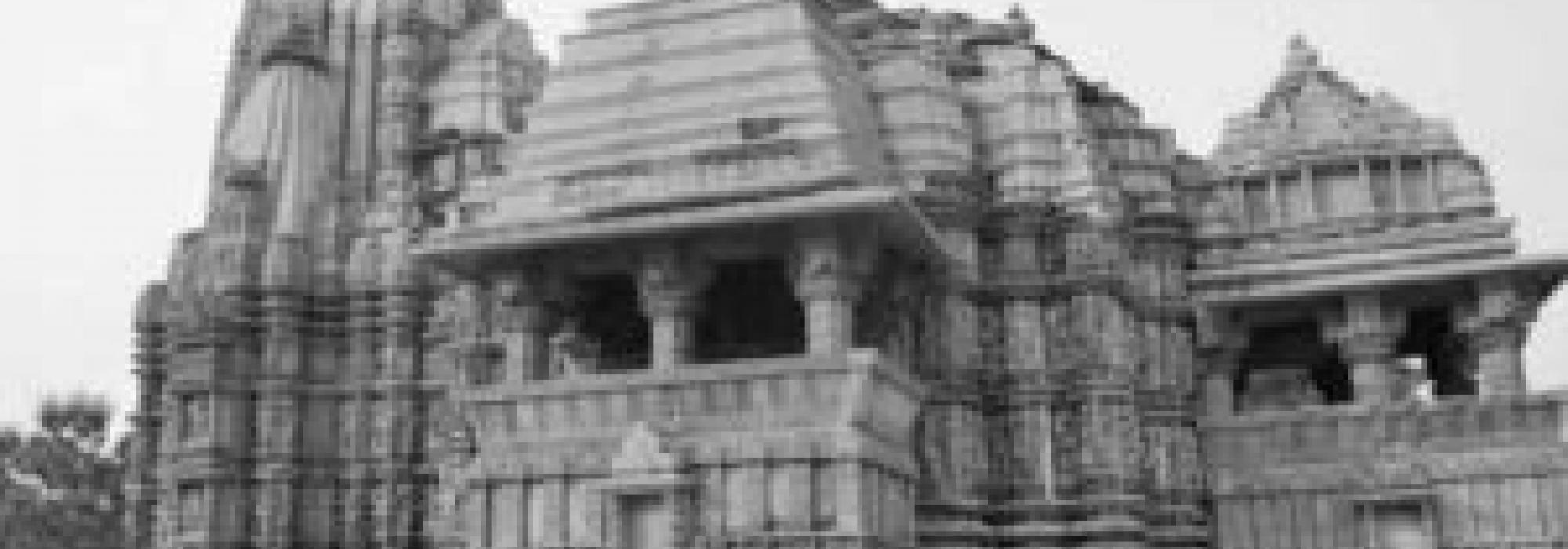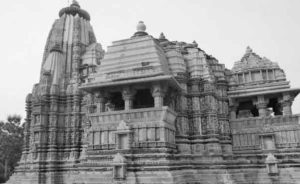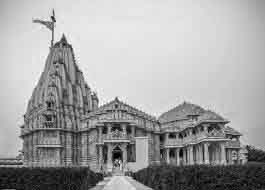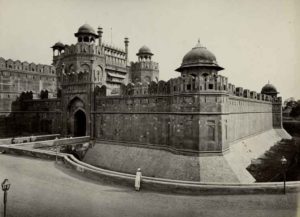The Shield of the Senas
Ramapala was the last of the
Pala emperors and he was overthrown by the rise of the
Senas, who were kshatriyas from
Karnataka. The foremost kings of this dynasty, which can be said to have come from the
Chalukya royal family of Karnataka, were
Vijayasena and
Lakshmanasena.
The Senas greatly valued Sanatana Dharma as well as the spirit of kshaatra. They also encouraged the arts and literature.
Umapatidhara, Sharana, Govardhana, Shrutidhara, Dhoyi, Vatudasa, Sridharadasa, Halayudha, and other Sanskrit poets flourished under the nourishment of the Senas. In fact,
Lakshmanasena and his father,
Ballalasena were themselves Sanskrit poets and pundits.
Ballalasena was also an expert on the dharmashastras. He wrote works like
Danasagara and
Adbhutasagara.
Lakshmanasena's poems have been included in
Sridharadasa's Saduktikarnamruta. In this anthology, there are several other beautiful poems by numerous Sanskrit poets. All these eminent people prospered under the benevolent rule of the
Palas and
Senas.
Among the available compositions from this era, perhaps the greatest and pioneering work was that of
Jayadeva. His magnum-opus,
Gita Govinda was the model for the music and literature of post-classical India. In the classical period,
Kalidasa's poems and plays offered a model and an inspiration for music, dance, sculpture, and the Sanatana Dharma culture; similarly, in the period of Islamic invasion and barbarism,
Jayadeva's work became a rallying point for music, dance, painting, sculpture, bhakti, and worship, providing a model for and inspiring those fields. Specifically, through its
madhura-bhakti, the
Gita Govinda became a treasure trove for the devotional compositions of generations of sadhus and saints.
Jayadeva's compositions have made their way into the
Guru Granth Sahib of the
Sikhs, thus giving the necessary emotional richness to that great warrior-tradition.
Not only that, when India was reeling under the bigotry of Islam that resulted in the destruction of the temple culture, primarily the
Kathashilpas (narrative sculptures) and
Bhavashilpas (emotional sculptures) were destroyed.
Jayadeva's Gita Govinda gave the inspiration to revive the Indian painting tradition, which in turn helped fill the void created by the barbaric iconoclasm of Islam.
Gita Govinda was responsible in preserving the ethos of our gods and goddesses, puranic lore, nature-culture oneness, and their myriad manifestations and transmitting them to the common people.
Kangda, Pahadi, Mewadi, Madhubani, Dakkhani, Patachitra, Rajaputhani, and numerous other schools of classical art have been inspired by the
Gita Govinda and have taken the concepts of
Nayaka-Nayaki bhava and
Raga-Ragini bhava, as well as the stories of
Rama, Krishna, Shiva, and
Shakti. During that miserable period when there was no opportunity for the creation of the
sthavara (static) – i.e. temples built with a great deal of effort, time, wealth, and expertise,
Sanatana Dharma stood its ground in the hearts of the people through the jangama (dynamic) – i.e. paintings and drawings that take lesser effort, time, and wealth. The credit to this goes in great part to the
Gita Govinda. And what formed as a nourishing ground for this great endeavour was the preeminence given to kshaatra by the
Senas.
Lakshmanasena faced the onslaught of the barbarian
Mohammed Bhaktiyar Khilji using strength and tact, t
hus preventing the conversion of the people of Bihar and Bengal to Islam. In this matter,
the Islamic chronicles blatantly lie when they claim that Lakshmanasena escaped from war. However, it is true that
Bhaktiyar Khilji’s journey of annihilation crushed under its ruthlessness the Buddhist universities of
Vikramashila, Odantapuri, and
Nalanda apart from numerous Hindu temples.
Lakshmanasena’s son
Keshavasena too fought against Islamic assaults. Several Islamic invaders such as
Malik Saifuddin fought against him and died at his hands. In sum, the
Senas gave importance to the
Shaiva-Vaishnava-Shaakta schools and balanced Braahma and Kshaatra to the best of their abilities.
After the decline of the Pratiharas, North India was largely ruled by several
Rajputs who lived in neighbouring regions and ruled their own small kingdoms. Among these, the pre-eminent ones include
Chandelas, Paramaras, Chahamanas, Gurjarachalukyas, and
Mewadi Guhilas. An acquaintance with a few of them becomes essential when seen through the lens of the Indian spirit of kshaatra. One of these great royal dynasties is the
Chandelas of Bundelkhand.
Accomplishment of the Chandelas
The
Chandelas who ruled
Bundelkhand having
Kalinjar as their capital, were originally Shudras. They became Karma-Kshatriyas solely on the strength of their valour.
Among the Chandelas,
Harshaputra Yashovarman has distinguished himself on the merit of his achievements. This warrior triumphed over
Siyaka of the
Paramaras,
Vigrahapala of the
Palas, and the crown prince of the
Kalachuris. The vast temple complex in
Kharjuravataha or
Khajuraho together with the
Chaturbhujanarayana temple stand as testimonies to how valour and piety and artistic feeling stood shoulder-to-shoulder in this king.
His son
Dhanga (950—1004 CE) is the greatest Chandela king. He extended the sway of his Empire and became an emperor of the stature of the
Gurjara-Pratiharas. He is the self-respecting Sanatani who courageously stood up to Subaktigin and Mahmud of Ghazni. The credit for completing the temples that his father
Yashovarman began goes entirely to
Dhanga. His grandson
Vidyadhara gave battle to Mahmud of Ghazni but couldn’t emerge victorious. He made a treaty with him and lost enormous wealth as a consequence. In spite of this, his suzerainty remained unthreatened.
Of the Chandelas who succeeded him,
Paramardhi (1165-1202 CE) distinguished himself as a commander of immense gallantry. Unfortunately, he was defeated in
Qutubuddin Aibak’s raid and had to accept a humiliating treaty. Infuriated that this humiliation had occurred under the watch of such a king,
Paramardhi’s own minister,
Ajaya Deva murdered his monarch! Later,
Paramardhi’s son,
Trailokyamalla declared war on
Qutubuddin, defeated him on the battlefield, and wrested back
Kalinjar, the capital city of his dynasty. This is among the countless such examples of how such kings displayed their glorious spirt of Kshatra.
In later periods, although the
Chandelas managed to secure their dominions, they had to throw up their hands, helpless in face of the repeated and barbaric onslaughts of Islam. Most notably, the glorious legacy of the
Chandelas who resolutely upheld Sanatana Dharma inspired warrior-rulers like
Chhatrasala who emerged much later. This is the eternal, noble contribution of the Chandelas to this country.
The Supremacy of the Chauhans
The
Chauhans were the most extensive among all of medieval India’s Rajput dynasties. They were also known as
Chahamanas. They arose in the Rajaputana regions of Shakambari, Ranathambhor, Nadol, and Jalor between the tenth and thirteen centuries and gradually spread out, and were engaged in constant battle with Muslim rulers.
The
Shakambari branch was the most significant of these. The extraordinary prowess of
Durlabharaja I is absolutely praiseworthy. As the vassal of the
Pratihara king
Vatsaraja, he had participated in an expedition against
Dharmapala.
Durlabha’s son,
Govindaraja I stood in support of the
Pratihara king
Nagabhata II and helped vanquish the Arabs in the Sindh region. Another ruler who emerged from this same tradition,
Vakpatiraja’s son
Simharaja eventually earned the title of “Maharajadhiraja” (King of Kings). By this period, the Empire of the Chahamanas had encompassed both the Eastern and Northern reaches of today’s Rajasthan.
Ajayaraja, the king hailing from that dynasty is the founder of today’s Ajmer city (or Ajayameru).
Vigraharaja who succeeded him won the Delhi-Punjab regions and earned renown after beating back Islamic invasions several times. The last great name hailing from this dynasty is
Prithviraj Chauhan III. Although his valour was truly incredible, he had to eventually perish at the hands of Mohammad Ghori’s skullduggery because of a lack of strategic thinking and keen insight.
Prithviraj III’s son,
Govinda was the founder of the Ranathambhor branch of the dynasty. Another notable king after
Govinda was
Veeranarayana, who successfully overcame Islamic raids. However, he was invited to Delhi by the despicable
Iltamush who in the guise of honouring him had him murdered in stealth and annexed Ranathambhor. However,
Veeranarayana’s maternal relative,
Vagbhata is the famed warrior who chased
Iltamush away and wrested Ranathambhor back.
Between 1248-1253 CE, every single contingent that the Delhi Sultan dispatched to Ranathambhor was decisively defeated and crushed.
Jaitrasimha, the son of
Vagbhata epitomized the brilliance of Kshatra like his father. Even he had triumphed over Islamic raids and held his head high. His son is the renowned and the supreme warrior,
Raja Hammira. In him we see the excellent blend of Brahma and Kshatra and it was he who successfully conducted the
Koti-Yajna, among other Vedic rituals. He fought
Jalaluddin Khalji with fierce valour. However, around 1300 CE, thanks to the wretched machinations of the crooked king
Alauddin Khalji, his own trusted aides like
Bhoja, Ratipala, and
Jayamalla emerged as traitors. The independence of Ranathambhor stood terminally threatened.
Alauddin Khalji not only lusted after
Hammira’s daughter,
Devala Devi, he also proposed extremely degrading terms for a treaty. The entire
Rajput clan was struck with revulsion at this depraved character of
Alauddin that they chose to fight to death. Accordingly, they gave a heroic call to all the women of Sanatana Dharma to commit Jauhar while they surged forth and fought this Sultan with unparalleled heroism on the battlefield and attained the proverbial
Viraswarga [literally, Heaven of Valour].
And so, with the death of the self-respecting and heroic
Hammira, that branch of the Chahamana lineage was extinguished.
Ashwapala’s son,
Anhila is the greatest ruler belonging to the
Nadol branch of the
Chahamanas. Not only did he defeat
Paramara Bhoja and
Bhimadeva of Gujarat, he also successfully faced multiple Islamic incursions and beat them back. However, it is a matter of tragedy that this dynasty met its closure in a raid unleashed by
Qutubuddin Aibak.
Among the rulers of the
Jalor branch of the
Chahamanas, the most exemplary name is that of
Kirtipala. Although he was a very devout adherent of Sanatana Dharma, he also made bestowed generous patronage to Jainism and other Dharmic sects. Equally, his son
Samarasimha earned prestige and goodwill by building temples, instilling awareness about Dharma, spreading knowledge and for his large-hearted generosity. This apart, being a shrewd practitioner of statecraft, he built impenetrable forts and cities. His period witnessed an era of great peace and prosperity. His son
Udayasimha, was a worthy successor. Not only did he extend the frontiers of his kingdom, he also faced
Iltamush’s attacks. Although he lost against the latter’s superior strategy, he earned respect for his valour. However,
Iltamush didn’t stop there. His innate Hindu hatred made him attack and besiege the Gujarat Vaghela king,
Viradhavala. Unable to tolerate this,
Udayasimha rushed to
Viradhavala’s assistance and repelled this Muslim incursion. His military prowess was matched by his love for art, both worthy of our admiration.
Indeed, it is a matter of great lament that this distinguished lineage had to finally meet its demise at the hands of
Alauddin Khalji’s bigoted aggression.
Other Rajput Dynasties
The
Gurjara-Chaulukas (or Chalukyas) are famous as
Solankis. Although
Bhimadeva (1022-1034 CE) is extremely renowned, he ran away to the safe haven of the Kutch region like a coward when
Mahmud Ghazni attacked
Somanath, thus leaving a disreputable scar on the spirit of Kshatra. Not just that. This foolish king repeatedly attempted to destroy exemplary heroes and leading lights of Sanatana Dharma like
Paramara Bhoja and
Kalachuri Karna. Fortunately,
Jayasimha (1094-1144 CE) not only blazed the glory of Kshatra, he also vanquished the Arabs in
Sindh and stood solid guard in defence of Sanatana Dharma. He constantly expanded his dominions and built numerous tanks, wells, ponds and temples. He upheld the value and prestige of the Brahma-Kshatra amalgam. But here is a tragic irony: his successor was a close relative named
Kumarapala who came under the spell of
Hemachandrasuri and embraced Jainism. He accepted the
Nivrttidharma or renunciation from worldly matters and thereby ebbed the spirit of Kshatra. And so, the Solanki Empire slackened after his death.
Govindachandra was the most capable ruler belonging to the
Gadhwal dynasty which ruled from
Kanyakubja-Varnasi. Not only had he won numerous wars, he also had an abiding interest in the arts. The
Krityakalpataru authored by his minister,
Lakshmidhara is an encyclopedia in the field of the Dharmashastras. His eldest son,
Vijayachandra had fought against an Islamic invader named
Khusrav Khan and won decisively. The infamous
Jayachandra (or Jaichand) was his son. However, recent research reveals that
Jaichand didn’t actually betray
Prithviraj Chauhan; on the contrary, he too fought against
Mohammad Ghori and died in battle. He extended patronage to renowned poets and pandits like
Sriharsha. The numerous Shiva-Keshava temples built by a host of kings belonging to this dynasty have been completely annihilated at the hands of Islamic religious fanatics.
The
Paramaras of Malwa are
Rajputs as well. The most prominent among these include
Munja and his younger brother’s son,
Bhoja. Bhoja’s father,
Sindhula was also a valorous king. Like
Bhoja, even
Munja was a great patron of poets and scholars.
Bhoja, the unalloyed adherent of Sanatana Dharma built great temples in numbers equaling the works he authored. He was the wheel that fused the chariot of the unity of Brahma and Kshatra.
The
Guhilots [the contemporary spelling is
Gehlot] who ruled the Rajasthan, Punjab, and Kathiawad regions originated primarily from the
Mewad area. They are also variously known as
Guhilaputras, Gobhilaputras and
Guhagotras. They originally descended from a Brahmana lineage and eventually earned a place of honour in the 36 prominent Rajput dynasties. This glorious dynasty gave birth to such towering Kshatriya titans like
Bappa Rawal, Ratna Simha, Rana Kumbha, Rana Sangramasimha and
Maharana Pratapa Simha. Eminences like
Rana Kumbha had attained equal excellence in wielding both scholarship and the arms. Without exception, every single ruler of this dynasty had been born with a sacred vow to defend Sanatana Dharma and to end the depredations of Islam. And when we recall the fact that the saint par excellence
Mirabai was born in this Guhila dynasty, we won’t remain untouched by the majestic accomplishments of this dynasty.
The
Tomars were another branch of Rajputs who flourished in the vicinity of Delhi. The
Red Fort in today’s
Delhi is largely the work of the untiring efforts of
Anangapala II belonging to this dynasty. He fought against Islamic incursions in multifaceted ways. This apart, he also built scores of Veda schools and temple complexes in and around today’s
Mehrauli or
Mihiravali. It was the same
Anangapala who rediscovered the rusted iron pillar of
Chandragupta Vikramaditya lying neglected in a forgotten place and established it here, in
Mihiravali. The
Tomars however, were defeated by the
Chauhans. However, in the reign of
Ferozeshah Tughlaq, they wrested
Gopagiri (today’s
Gwalior) from him and stood as bulwarks of Sanatana Dharma in the region for one hundred and fifty years. But then, for all their brilliant and courageous battles against repeated Islamic raids, they finally succumbed in the face of
Ibrahim Lodi’s unremitting barbarism.
At any rate, in the post-Pratihara era, the
Rajput clans which split into numerous branches calling themselves as descendants of the Surya, Chandra or Agni Deities, blazed a glorious trail of the Kshatra spirit in North-Western and Middle India. In reality, all these brilliant and war-ready clans represent the continuation of ancient India’s
Ganas (Republics) of
Madra, Malawa,
Yaudheya and others. Not just that. They also represent a later transmogrification of the
Brahmana, Shudra, Shabara, Kirata and
Pulinda clans that chose Kshatra as their primary avocation. In some cases, it is argued that we can detect an aspect of the
Greeks, Shakas, Kushanas and
Huns who embraced Sanatana Dharma and became Bharatiyas in the true sense of the word. However, according to some scholars, this possibility is in the realm of guesswork that’s farfetched.
However, despite their obvious flaws like disunity, constant infighting, and a misplaced sense of self-respect transcending death, the Rajputs stand out as extraordinary warriors, as blazing illustrations of the spirit of Kshatra, and as faultless adherents of Hindu culture. But for the dogged resistance pitched by these Rajput dynasties, India would’ve surrendered to Islam ages ago. And when we realize this savage truth, we do begin to fully appreciate the true value of these Kshatriya clans.
To be continued
Translated by Hari Ravikumar and Sandeep Balakrishna



















































